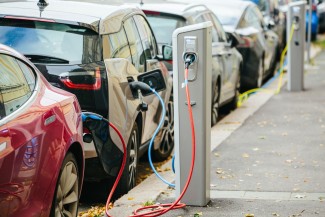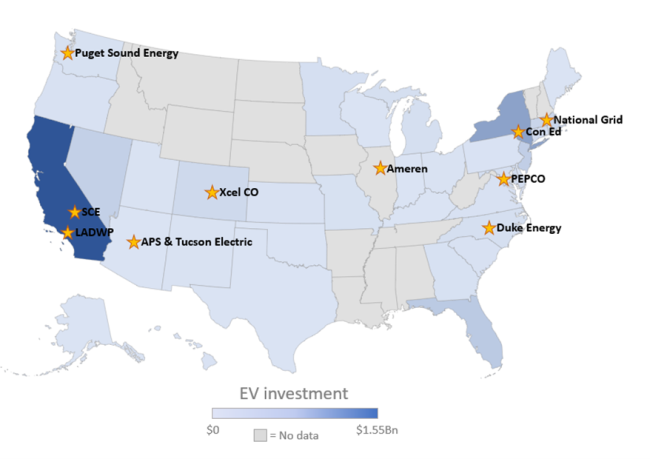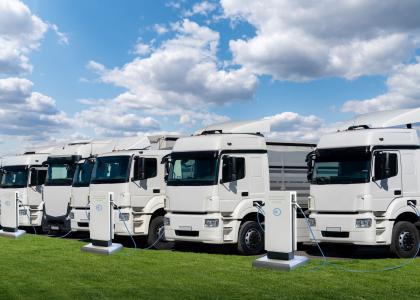Electric vehicle registrations are up 60% this year, and over the last decade, regulators have approved more than $3 billion dollars in utility transportation electrification investments. Amid the surge in electric vehicles, ACEEE found utilities are supporting an increasingly wide range of electrification efforts, including investments in charging infrastructure for apartment building residents and vehicle fleets, as well as education and outreach efforts. Our report calls for utilities to engage in more transparent and comprehensive planning and to focus investments not just on personal passenger vehicles but also on transit fleets, heavier classes of vehicles, and rideshare vehicles—while centering equity to ensure underserved communities benefit from the transition to low-emission vehicles.
The acceleration of electric vehicle (EV) adoption is driven by declining battery prices and supportive policies at the state level. California plans to phase out internal combustion engine automobile sales by 2035, a policy expected to be adopted by other states. Another California regulation aims to electrify medium- and heavy-duty sector truck fleets.
EVs benefit drivers and society with lower costs and cleaner air. However, communities that are underserved by EV charging today must be supported so they can share in the benefits of EVs and not be left behind. Millions of new EVs on the road will mean greater demand for electricity charging infrastructure, making it essential for utilities to prepare for electrification. The level of planning and investment by utilities across the country varies significantly, but some trends are emerging.
ACEEE assessed transportation electrification (TE) planning efforts among 10 investor-owned utilities and one municipally owned utility, each chosen for having recently submitted plans and representing the range of utility involvement in TE. These 11 utilities varied in their level of TE planning and investment and hailed from a diverse set of states that are at different stages of the EV transition. ACEEE looked at both the content of TE plans and the underlying planning processes. We examined efforts across seven criteria: coverage of vehicle types and overall program scope, rates and managed charging, incentives, equity, education and marketing, metrics and progress reporting, and system planning.
Map of Utilities Evaluated and State EV investments
Data on approved EV investments by state from Atlas EV Hub (2022)
Emerging Trends
We found several emerging trends in infrastructure investments, non-infrastructure activities, and the inclusion of equity and education. Investments in L2 charging, typically providing 10 to 20 miles of range an hour and best suited for overnight charging, were more common than investments in direct current fast charging (DCFC), which can provide almost a full charge in under 30 minutes but entails higher upfront installation and infrastructure costs. Make-ready investments, in which the utility pays most or all of the costs to make a site ready for a charger to be installed by the site owner, were more common than utilities owning the charging infrastructure, including the charger itself.
Investments in charging infrastructure at apartment and condo buildings, which often present greater challenges and costs than charging at single-family homes, were also common. Many make-ready programs focused on apartment and condo buildings to ensure residents could take advantage of at-home charging, which is more convenient and generally cheaper than public charging.
A common investment outside of physical charging infrastructure was electric rates that prioritize charging when it is most opportune for the grid, often referred to as time-of-use (TOU) rates. These rates reduce the strain EVs can have on the electric grid and can even allow EVs to take advantage of times when the grid is not at full capacity or when there is abundant renewable energy generation. On a sunny day, or overnight when wind may be blowing the strongest, renewable generation will likely be at its peak and can even coincide with times when overall electricity demand is relatively low. Xcel Energy Colorado’s TOU program charges almost five times more per kilowatt-hour for charging during the peak summer hours of 9am to 9pm, when electricity demand is at its highest. Services to assess the costs and benefits of electrifying for fleet operators were also common among utility programs.
Equity and education to address inequities in past transportation investments were also common. Southern California Edison, for example, plans to dedicate 50% of its spending to disadvantaged communities and has reached out to these communities to prioritize public fast-charging investments. Other utilities have set aside funding for underserved communities, although criteria varied for which communities to include, and plans for community engagement were. More utilities had broad plans to educate the public about the benefits of EVs, including partnerships with auto dealerships, where many people may encounter EVs for the first time.
Ensuring Comprehensive Transportation Electrification Plans
After reviewing 11 utility TE plans, ACEEE recommends:
- Utility planning efforts need to be more transparent and consistent to ensure accountability.
- The planning process should be ongoing, ideally requiring a new plan every few years that gives updates on progress and allows for input from regulators and the public.
- Planning efforts should cover all TE use cases including passenger vehicles, trucks and other heavier classes of vehicles, as well as transit, micro-mobility, and rideshare vehicles.
- Equity must be included throughout to ensure that everyone benefits from the TE transition and that underserved communities are meaningfully engaged. This includes engaging early and often to assess these communities’ needs.
- Utilities should develop metrics and goals related to infrastructure development while also considering a wide variety of outcomes related to greenhouse gas emissions, air quality, and equity.
We found that only seven states in the country require their utilities to submit comprehensive TE plans that put their TE strategy, programs, and impact in one document for public and regulatory scrutiny. Our evaluation included three such plans from the joint Arizona Public Service and Tucson Electric Power company filing, Puget Sound Energy in Washington State, and Xcel Energy in Colorado. These plans and planning processes are the most thorough and allow for optimal accountability and consistency. They generally also include a high level of detail about a utility’s TE strategy and plans for the short, medium, and long term.
Utility TE planning can take many forms, and approaches vary across the country, but we identified principles that regulators and utilities should adhere to as they develop their programming. The transition to electrified transportation will take decades, involve many stakeholders, and require significant investments in charging infrastructure and grid updates. Comprehensive planning by utilities can help ensure that TE investments serve different types of vehicles and deliver the greatest benefits, especially to underserved communities, while allowing for public input and participation.




